The sacred city of Anuradhapura, Sri Lanka, is made up of monastic complexes dedicated to different sects of Buddhism including Theravada, Mahavihara, and Mahayana. It also has four monumental stupas (Jetavana, Ruyanvelisaya, Mirisavati and Abhayagiri).
Visitors can also see the ruins of fortified walls and a system of moats that protected the secular part of the city known as the Citadel. The outskirts of Anuradhapura were mainly used for agriculture. A remarkably advanced water hydraulic system allowed for year-round irrigation.

The main sights are contained in an archaeological park that requires quite a bit of walking from one site to another. Tickets cost $25 USD and are sold at the Archaeology Museum (open daily 8:30 a.m. to 5:30 p.m., closed Tuesdays).
Tuk-tuks are readily available to take you around to the different sites within the park. Many tuk-tuk drivers will say that you do not have to buy a ticket and they can get you in without one, but we recommend every visitor buy a ticket in order to support maintenance and restoration efforts.
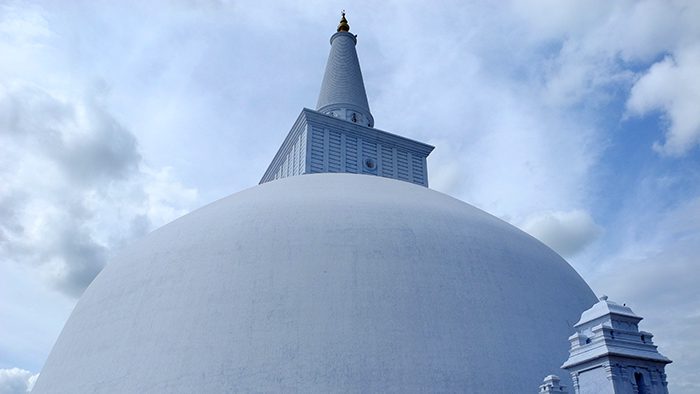
We also suggest hiring an English-speaking tour guide, which will greatly enhance your knowledge and experience of Anuradhapura. The cost for a private guide varies, but prices generally fall between 850 and 1,000 LKR per day. Do not worry if you have not pre-booked a guide; tour guides are available at the entrance to the city.

Here is what to see and do in Anuradhapura!

From the Ruwanwelisaya stupa complex, a five-minute walk along a sidewalk promenade, past picnickers and curious monkeys, brings visitors directly to the Sri Maha Bodhiya, or the Sacred Bodhi Tree. This sacred fig tree was propagated from the original Bodhi Tree under which Siddhartha Gautama achieved enlightenment. Siddhartha Gautama was the young Indian prince who founded the Buddhist religion. He is also referred to as Gautama Buddha, or known simply as the Buddha.

While it is not uncommon to come across 2,000-year-old olive trees in Greece and the Middle East, the Bodhi Tree in Anuradhapura was planted in 288 B.C., making it the oldest living tree in the world! It is protected by a wall and revered by thousands of Buddhist pilgrims who come to pay it homage every day of the year. This impressive Bodhi Tree is one of the most sacred Buddhist relics in the world and is constantly being adorned with strings of prayer flags of blessings for protection, peace, and good fortune.
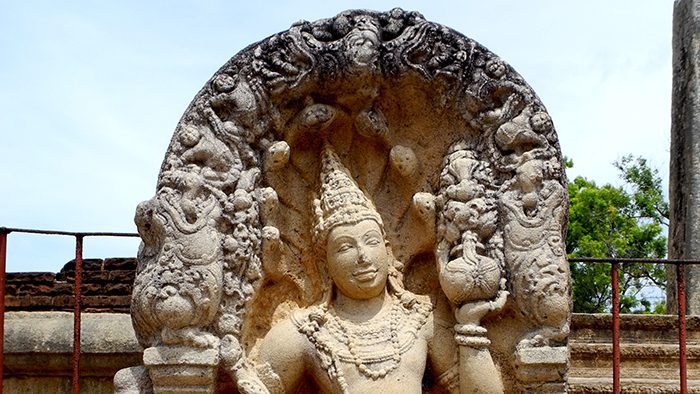
The Ratna Prasada, or Jewel Palace, is a monastic complex that was used by a sect of monks who practiced Mahayana Buddhism – a split from the Theravada school of thought that dominated Anuradhapuran religious life. King Kanitthatissa originally built Ratna Prasada in the first century. The building, which was an enormous structure in its heyday, was demolished during the Dravidian invasion around the 8th century. It was later rebuilt during the reigns of King Mihindu II and King Mihindu IV.
Check out Visiting the Sigiriya Rock Fortress
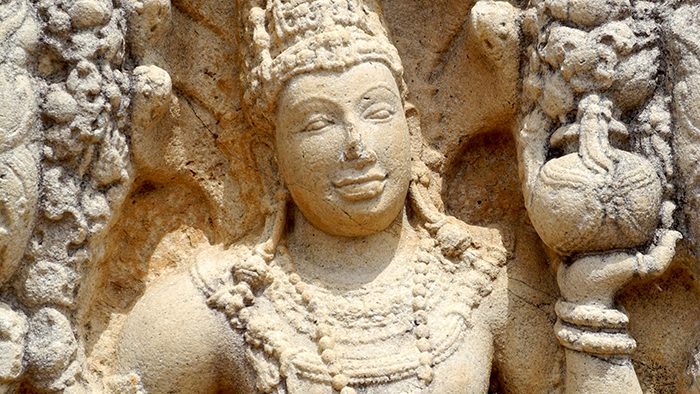
One of the most noteworthy ruins of Ratna Prasada is an 8th century guard stone featuring a stone-carved naga king, or cobra king, holding vessels of abundant prosperity. In his left hand, he holds a pot of plenteousness. In the right, he holds a flower bouquet. The guard stone is in surprisingly excellent condition for a 1,200-year-old artefact, but it only represents half of the original pair that stood at the entrance to the monastery. These guard stones served as a means of protection over the monks of Ratna Prasada and their riches.

Located at the north end of Anuradhapura is the Abhayagiri Vihara monastic complex. It was constructed by King Vattagamini in 88 B.C. and had the capacity to house 5,000 monks at a time. For nearly 600 years this was the largest monastery in Sri Lanka. The property, which extends over 500 acres, features Buddha statues, a stupa, one of the most outstanding moonstones in Sri Lanka (see below), and two very famous bathing pools, the Kuttam Pokuna.

The “twin ponds,” as they are referred to, were constructed sometime between the 8th and 10th centuries B.C. Although their design might look simple enough, their plumbing is anything but. The Anuradhapurans were master engineers, as evidenced by their elaborate irrigation systems. The twin ponds feature underground ducts used to filter, fill, and empty the pools of water. In addition to their impressive plumbing, the design of the pools shows an eye for elegance.

The monks could enter the pools using several sets of granite stairs, or sit along the edges and use vessels to bathe without having to submerge themselves. Contrary to their name, the twin ponds are not actually twins at all. One has an area of 6,732 square feet, while the smaller of the two measures 4,641 square feet. Gardens and a protective wall surround them. Even though visitors are not permitted to enter the water, it would be a shame to come to Anuradhapura and miss these beauties.
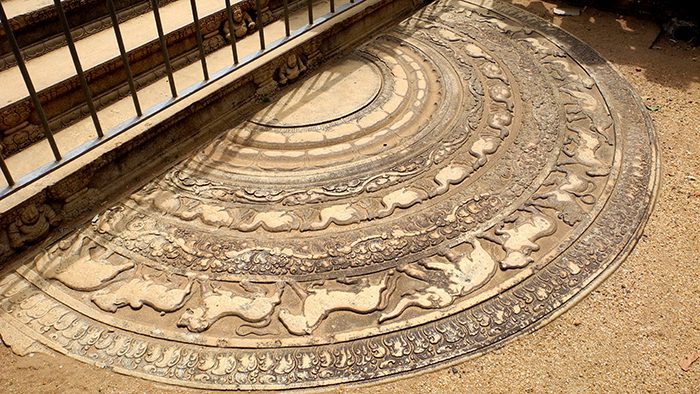
A Sandakada Pahana, or Moonstone, is a distinctive Sri Lankan architectural element developed during the later years of the Anuradhapura Kingdom. A moonstone is a semi-circular carved slab of stone traditionally placed at the entrance of a Buddhist temple. The Sandakada Pahana at Abhayagiri Monastery dates back to 1st century B.C. A lotus blossom leaf is depicted in the center and is surrounded by rows of animals, each of which represents a stage of life.

The elephants represent birth, bulls represent aging, lions represent disease, and the horses signify death. The swans, on the other hand, are believed to represent the forces of good and evil at play during one’s lifetime. The moonstone, then, is interpreted as a depiction of transcending worldly temptations and reaching the ultimate goal of Nirvana, which is symbolized by the lotus flower. The image of the lotus flower is found in architecture throughout Asia and is considered a sacred figure in Buddhism.
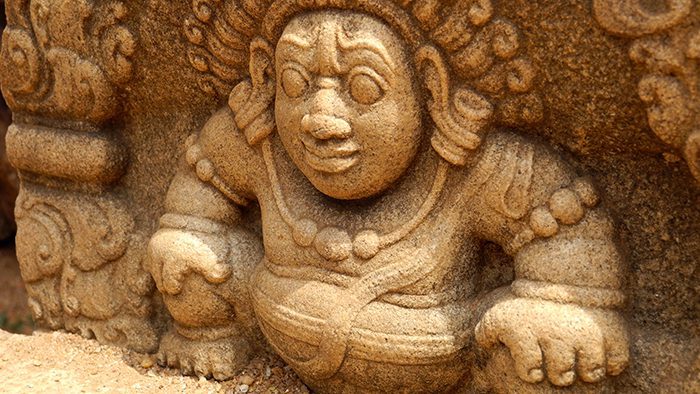
The use of moonstones carried into the Polonnaruwa period. By then, the designs of the moonstones had changed slightly and were used at the foot of other buildings, not just at the entrances of Buddhist temples.

The Isurumuniya Vihara is a monastic complex carved out of solid rock. Built by King Devanampiyatissa, it was used to house 500 ordained Buddhist monks, or issira. Typically, issira were children from noble families in high castes willing to dedicate their lives to the teachings of Buddha and the path to enlightenment. Once they were ordained, they lived apart from the rest of Anuradhapuran society.

Pilgrims bring flower offerings to a statue of a reclining Buddha, who is dressed in a bright crimson robe and housed within one of the shrines. The statue is surrounded with vibrant paintings depicting the Buddha’s life and legends of the Anuradhapurans’ ancient world. Giant boulders, some of which feature carvings of elephants and other figures, are scattered throughout the complex. There are also several shrines, pillars, statues, and a stupa.
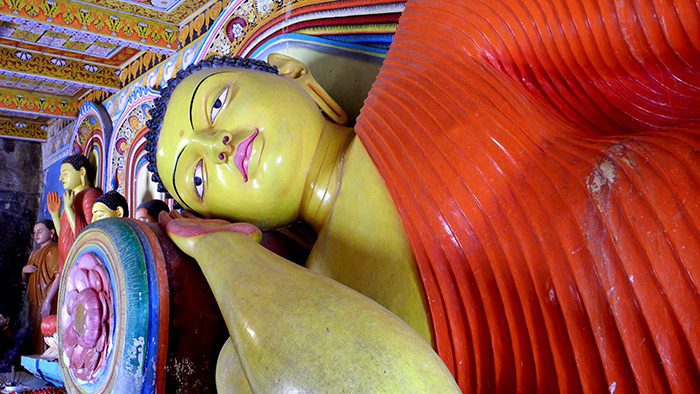
A museum inside the monastery displays carved stone fragments that once adorned the Isurumuniya complex. These include stone benches and carved portraits of the royal family dating back to the 6th and 7th centuries B.C. Visitors can climb the stairs to the top of the highest boulder for a fantastic view of the property.

Near the Isurumuniya Vihara is the Magul Uyana, a complex of ancient bathing ponds said to be the place where Prince Saliya, son of King Dutugamunu, became enamored with a maiden girl named Asokamala. According to legend, the prince married his love despite her not being of noble blood, thus forfeiting the throne to his uncle. Their love is immortalized in a 6th century stone carving, which is housed in the museum. Admission to Isurumuniya Vihara is 200 LKR.

The Jetavanaramaya Monastery and stupa were built by King Mahasen (273 – 301 A.D.) It has a height of 122 meters and is believed to have been one of the tallest structures in the ancient world when it was completed, second only to the Egyptian pyramids at Giza. Built with bricks made of sand and clay, the Jetavanaramaya stupa is as much a testament to ancient engineering as it is to spirituality. A part of Buddha’s sash, a religious relic, is said to be enshrined here. Gazing up at this architectural feat, you will be in awe of the ancient world of Anuradhapura.
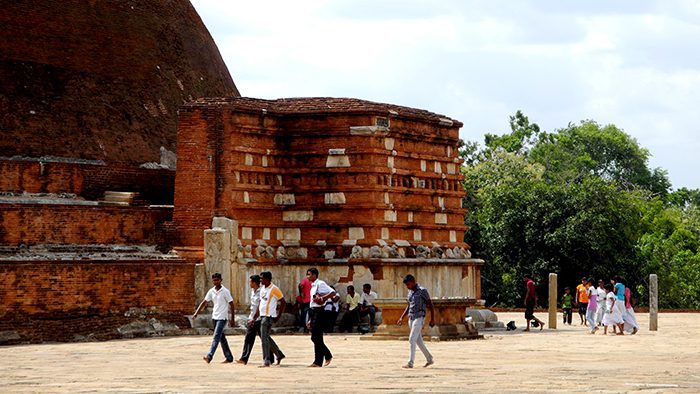
Like many other ancient societies that came before them, the Anuradhapurans willing to spend over 20 years and use hundreds of skilled laborers to erect a monument honoring religion and the divine. The Jetavanaramaya Museum, which is located next to the stupa, exhibits archaeological finds made on site during reconstruction efforts. Items on display include religious objects, jewelry and coins. Admission to the museum is free.

Known as the “Great Stupa,” the Ruwanwelisaya stupa is an enormous white structure that predates the Jetavanarama stupa by over 100 years. King Dutugemunu, who became ruler after defeating King Elara, commissioned its construction in 161 B.C. Sadly, he did not live long enough to see its completion. The gleaming white monument is quite large, with a height of 91.4 meters and a circumference of 290 meters. It is the second highest stupa in Anuradhapura and continues to be an important place of worship.

The large white dome represents heaven – its design was inspired by a bubble floating on water. Many believe that relics of the Buddha are housed within the dome. The square portion above the dome represents the Four Noble Truths, while the eight rings represent the Noble Eightfold Path – both are touchstone teachings of Buddhism. There is also much to discover around the pavilion.

Rows of carved elephants and layers of exposed brick provide both support and decoration to the structure. Visitors light coconut oil votives along a wall adorned with statues of elephant heads. The Ruwanwelisaya site also has smaller ruins and freestanding pillars that were once part of the sacred complex. Pilgrims leave offerings of flowers and food at small shrines.

Built, destroyed, and restored throughout the ages, the Thuparamaya Dagoba is the oldest stupa in Sri Lanka. Though not as impressive as other stupas in Anuradhapura, it is sacred because it holds a collarbone relic of the Buddha. The structure that we see today is a complete reconstruction that was done in 1862, although some of the original pillars still stand around the main building.

King Devanampiyatissa originally built Thuparama Dagoba in the 4th century to house the collarbone relic. Other remnants from the original dagoba include pillar bases, stone carvings, temple ruins, and a beautiful moonstone.
Other Points of Interest

Mihintale is a Buddhist pilgrimage site and religious complex located approximately 13 kilometers east of Anuradhapura. It is believed that this is where Mahinda converted King Devanampiyatissa to Buddhism. Mahinda was the son of an emperor from India, but chose a path of devotion and instead became a Buddhism monk. Mihintale, or “Mahinda’s Mountain,” eventually became the cradle of Buddhism and Sinhalese culture. For centuries, it was a complex of cave dwellings, monasteries, and stupas used by monks. Thankfully the ruins of some of these buildings can still be seen today, making Mihintale the perfect day trip from Anuradhapura.

In order to service the thousands of Buddhist monks who lived in Mihintale, King Sena II (853-887 A.D.) had a hospital built at the base of the mountain. By examining the ruins, archeologists have been able to determine the original layout of the building. The hospital had a courtyard and four main rooms used for consultation, preparation, supply storage, and bathing.
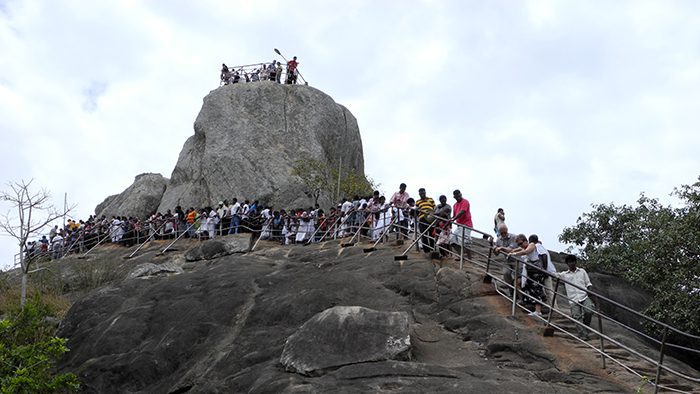
The great stairway is another feature of Mihintale that has survived the centuries. Its impressive 1,840 steps scale the mountainside, bringing visitors to the first level of the Mihintale complex. Here lie the ruins of the main dining hall and the main shrine, which is accessed via another flight of stairs and features two large, inscribed stone slabs.
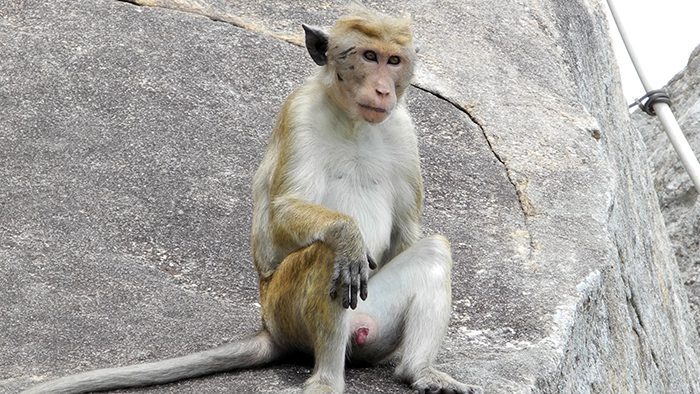
Other ruins to visit at Mihintale include the Lion Pond, Naga Pond, Mahinda’s Cave, Kantaka Cetiya stupa, Maha Stupa, and the Aradhana Gala rock. Aradhana Gala is often referred to as “meditation rock” or “rock of invitation.” According to legend, it is where Mahinda first met King Devanampiyatissa. Visitors ascend the ancient stairs, with the help of railings, to the top of Aradhana Gala. From here there are incredible views, especially around sunset. The month of Posen (June) brings in many Buddhist pilgrims to Mihintale, and Posen Poya is the holiest day of the year (usually the day of a full moon in June). Entrance to Mihintale is 500 LKR.

The cheapest way to get to Mihintale from Anuradhapura is to hire a tuk-tuk. There are many English-speaking guides waiting around Mihintale if you are interested in hiring one to show you the sights for a few hours. Shoes are not allowed past a certain point. Bring a fresh pair of dark socks if you do not wish to walk barefoot on sand and pebbles. We suggest visiting in the early morning or late afternoon hours to avoid the heat.
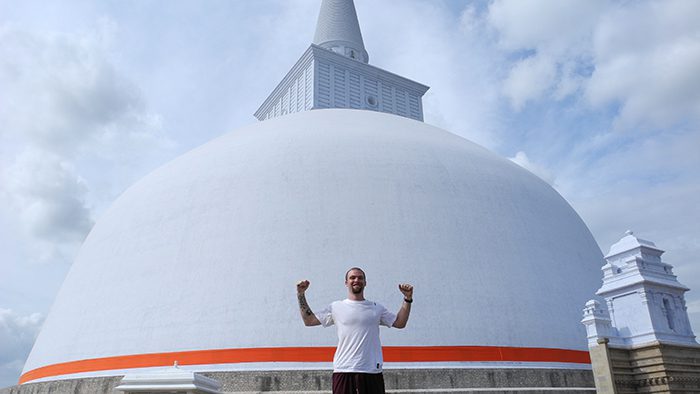
Exploring the sacred city of Anuradhapura is much like going to visit Mayan ruins in Guatemala or Roman ruins in Italy; you must be able to appreciate the accomplishments made by ancient societies through what is left of their infrastructure. Each site at Anuradhapura tells a story. It is evident how important religion was to this ancient society, and how pivotal the kingdom was in spreading Buddhism throughout Sri Lanka.

It is important to know that there are significant distances between some of the attractions, and so transportation will be needed to make the most of each day. Tuk-tuks are always available to take you around to each of the sites, but a personal tour guide/driver can also be hired for the day if you so choose. Comfortable walking shoes, sunglasses, sunscreen, and airy clothing are a must for touring Anuradhapura. Most stupa sites require all guests to remove their shoes (this is where socks come in handy) and dress appropriately as a form of respect. All the sites I visited feature free admission, but donation boxes are set up to help cover maintenance costs.

Monkeys, birds, lizards and fruit bats are just some of the local critters you will encounter at each of the sites. Remember that the monkeys are wild, and although they seem tame, I advise that you never touch or try to feed them. They have the ability to pass on quite a few nasty things to people that surely you do not want to take back home with you. Plus, they are notorious for stealing things.
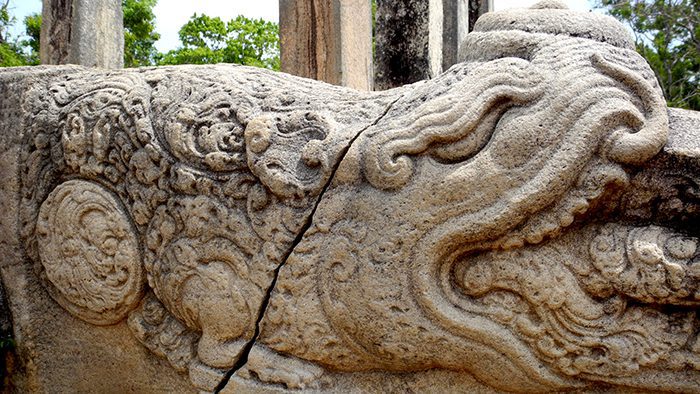
A day trip to nearby Mihintale will complete your education of Sri Lankan Buddhist culture. The complex is truly amazing and in surprisingly good condition for its age. The monks who lived here made a self-sufficient city perched in the mountains, which is still a holy place for Buddhists today. Both Anuradhapura’s sacred city and Mihintale’s monastic complex will transport you back to a sliver in time when kings ruled and the teachings of Buddha held dominion over every facet of society. I sincerely hope you enjoy and appreciate your time spent in Anuradhapura among the ruins before heading off on your next Sri Lankan adventure.
Time zone: GMT +5:30 hours (Indian Standard Time)
Capital city: Colombo
Languages spoken: Sinhalese, Tamalese and English
Currency: Sri Lankan rupee (LKR)
Currency converter: XE
Getting around: When traveling between cities, buses and trains are best. Buses can be really crowded and are seldom air-conditioned. Though trains are slower and can be crowded as well, they often considered the more comfortable mode of transportation. When in the city, tuk-tuks, buses, taxis, and, in many cases, simply walking, are all viable forms of transportation. In some cases, cars and drivers can be hired for a day or bicycles can be rented.
Shopping: There are several souvenir shops in the Anuradhapura Old Town where postcards and chotchkies are sold. The New Town has clothing stores, supermarkets, and a handful of bookshops.
Tipping policy: Service fees, typically 10%, are included at most restaurants. Drivers and guides will also expect tips. A tip of 50 LKR is acceptable for hotel doormen and the people who collect guests’ shoes at the temple.
Electricity: There are two types of sockets, the Type D Indian 5 amp BS-546 and the European CEE 7/16 Europlug.
Airports:
Bandaranaike International Airport (BIA)
Sri Lanka Colombo Airport (CMB)
Entry/exit requirements: As of January 1, 2012, all holiday and business travelers to Sri Lanka must have an Electronic Travel Authorization (ETA). This can be obtained online through the Sri Lanka Electronic Travel Authorization System website.
Health and safety: Though cases are rare, dengue fever is endemic to Sri Lanka. The mosquito-borne illness, though treatable, has potential to be fatal. The only way to prevent contracting the dengue virus is by avoiding getting bitten by mosquitoes. Use a reliable cream or spray insect repellent to keep mosquitoes at bay and sleep under a mosquito net whenever possible. Symptoms usually begin four to seven days after being bitten by an infected mosquito. Seek medical treatment if you think you have dengue fever. Adequate emergency medical treatment in private hospitals can be expensive. It is advisable to have travel health insurance coverage during your stay. We recommend the Explorer package by World Nomads. To avoid unwanted attention, refrain from displays of wealth including wearing expensive jewelry and producing large amounts of cash.
Best time to go: Sri Lanka has two monsoon seasons, which means your trip does require some pre-planning. The dry season in the south western area of the country is between December and March. The dry season in the northern and eastern sections of the country lasts from May to September. Between October and November, sporadic rains occur throughout the country. December through March is the most popular and the driest time to visit.
Have you visited Anuradhapura before? What did you think of what to see and do in Anuradhapura? Leave a comment below!
Counter
101 Countries • 1432 Cities
Polonnaruwa - BackpackerTrack.com says:
[…] on all the main sites and some images of each one. I also found this detailed blog post at DavidsBeenHere.com/anuradhapura/ to be quite useful. Use these resources in conjunction with the map I have created below as you […]
Anuradhapura - BackpackerTrack.com says:
[…] on all the main sites and some images of each one. I also found this detailed blog post at DavidsBeenHere.com/anuradhapura/ to be quite useful. Use these resources in conjunction with the map I have created below as you […]